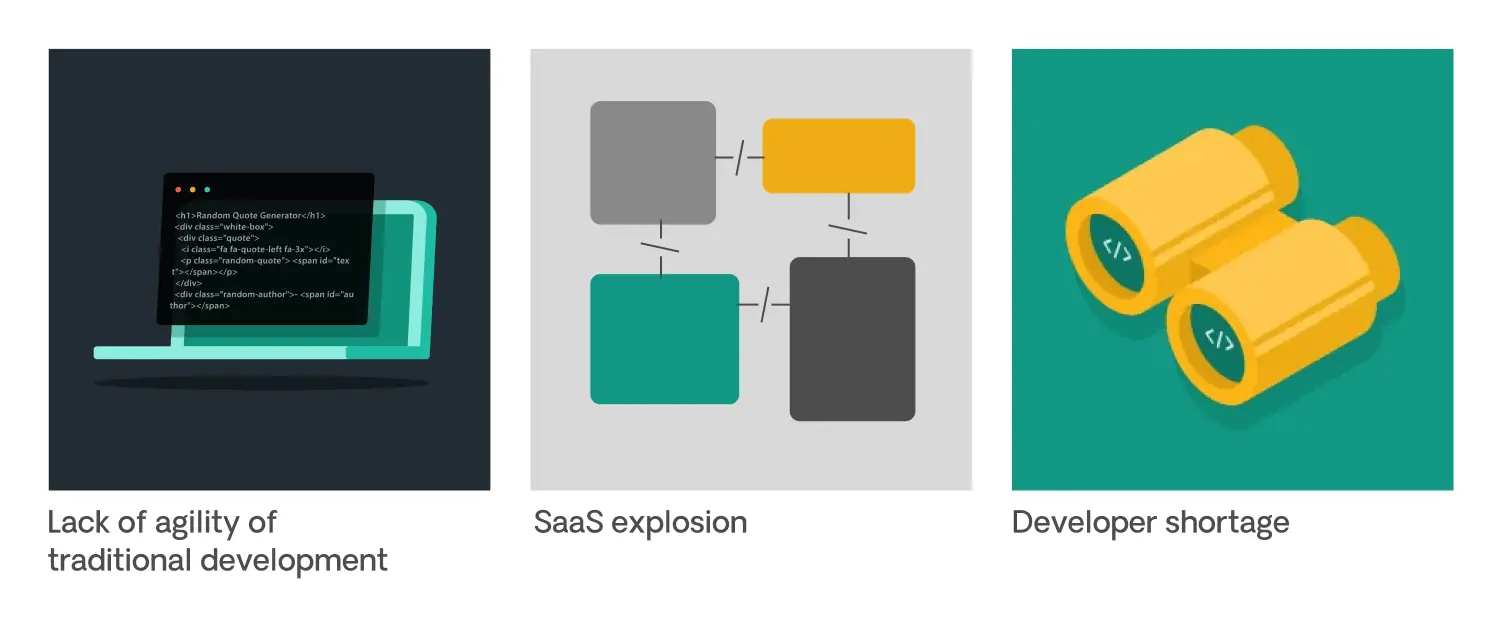Low-code development has been experiencing a surge in popularity, with its market projected to achieve a remarkable $29 billion in revenue by the year 2025. But what exactly is low-code? What advantages does it offer, and what kind of applications can you create using this approach?
Low-code refers to a development approach that empowers individuals, regardless of their technical expertise, to build software applications with minimal hand-coding. It provides a visual, drag-and-drop interface combined with a set of pre-built components and templates, allowing users to assemble applications quickly and efficiently.

This app development method eliminates the need for extensive manual coding, making it accessible to a broader range of users, including business analysts and citizen developers.
The benefits of low-code are manifold:
Firstly, it offers a substantial reduction in the time and effort involved in application development. Through the utilization of pre-existing modules and visual design tools, developers can expedite the entire development process, leading to quicker delivery of software solutions to the market. This enhanced efficiency also facilitates rapid prototyping and iterative development, empowering organizations to promptly adapt to evolving business needs.
Secondly, low-code platforms promote collaboration between business and IT teams. With a user-friendly interface and simplified development process, stakeholders from various domains can actively participate in the application creation process. This collaborative environment fosters better communication, alignment, and understanding of business needs, ultimately leading to improved software outcomes.
Furthermore, low-code empowers organizations to address the shortage of skilled developers. By enabling non-technical individuals to create applications, low-code platforms alleviate the burden on IT departments, allowing them to focus on more complex and specialized tasks. This democratization of software development widens the talent pool and facilitates innovation across the entire organization.
As for what you can build with low-code, the possibilities are extensive. Low-code platforms support the creation of a wide range of applications, including but not limited to:
- Business process automation (BPA): Develop workflows and automate repetitive tasks to streamline business operations.
- Customer relationship management (CRM) systems: Build applications to manage customer interactions, track sales, and improve customer service.
- Content management systems (CMS): Create platforms for publishing, organizing, and managing digital content.
- Employee portals and intranets: Design internal websites that facilitate communication, collaboration, and access to company resources.
- Mobile applications: Develop cross-platform mobile apps that run on iOS and Android devices.
- Data dashboards and analytics tools: Build visually appealing dashboards that provide real-time insights and data visualization.
- E-commerce platforms: Construct online shopping websites with features like product catalogs, shopping carts, and payment gateways.
- Workflow management systems: Create applications to automate and streamline complex business processes.
These examples represent just a fraction of what can be accomplished with low-code development. The flexibility and versatility of low-code platforms empower users to bring their ideas to life quickly and efficiently, making it a compelling choice for organizations seeking to accelerate their application development initiatives.
Why Is Low-Code Development Popular?
Development teams face immense pressure to meet the rising customer expectations and expedite digital transformation endeavors. The demand for developing novel business solutions shows no signs of abating, placing further urgency on these teams.
The conventional development approach was not built to match the present-day requirement for rapidity, and the extensive adoption of Software-as-a-Service (SaaS) driven by independent business teams has now reached a stage where it hampers productivity.

Moreover, acquiring developer talent has become increasingly challenging. The demand for engineers surpasses the available supply, leaving a significant gap in fulfilling existing development requirements.
As a result, there has been a notable surge in the adoption of low-code platforms as an alternative solution.
Is Low-Code Difficult?
Low-code development is generally known for its user-friendly learning curve, although the level of difficulty may differ across platforms. Platforms aimed at business users, sometimes referred to as no-code platforms, offer simplicity but may be limited in terms of advanced functionality.
On the other hand, platforms targeting professional developers require some coding knowledge and technical expertise. Nonetheless, all low-code platforms are designed to be more accessible and easier to learn and utilize compared to traditional development tools and programming languages.
When assessing low-code platforms, it is crucial to consider the integration of both business and IT perspectives, fostering collaboration between the two. A well-rounded solution should cater to both user personas, facilitating effective cooperation between business users and technical professionals.
Can You Do Cloud Development With Low-Code?
Advanced low-code platforms offer the flexibility to deploy applications either on-premises or in various cloud environments, including public, hybrid, or private setups. Moreover, low-code development can support the entire journey of transitioning to the cloud. According to a recent study conducted by IDC, there is a direct correlation between higher levels of cloud maturity and an increased number of new applications created using low-code.
However, when considering cloud development, it is important to take into account additional factors beyond simply running applications in the cloud. This is where different low-code platforms come into play, offering diverse capabilities to address these requirements.
For instance, Alpha Software goes beyond basic cloud deployment by empowering developers to seamlessly utilize, integrate, and orchestrate a wide range of cloud services. This ensures that developers can focus their efforts on coding superior user experiences during development sprints, rather than spending excessive time connecting and managing various cloud services.
ទិញគ្រីបតូឥឡូវ
The Future Of Low Code
Low-code is enabling organizations worldwide, from individual departments to entire enterprises, to revolutionize their approach to solving business challenges.
By leveraging low-code, you can propel your digital strategies forward, swiftly building and innovating solutions that generate exceptional business value.
With its proven track record, low-code stands as the future of application development, promising a paradigm shift in the way we create software solutions.
Source: https://econintersect.com/what-is-low-code-development
